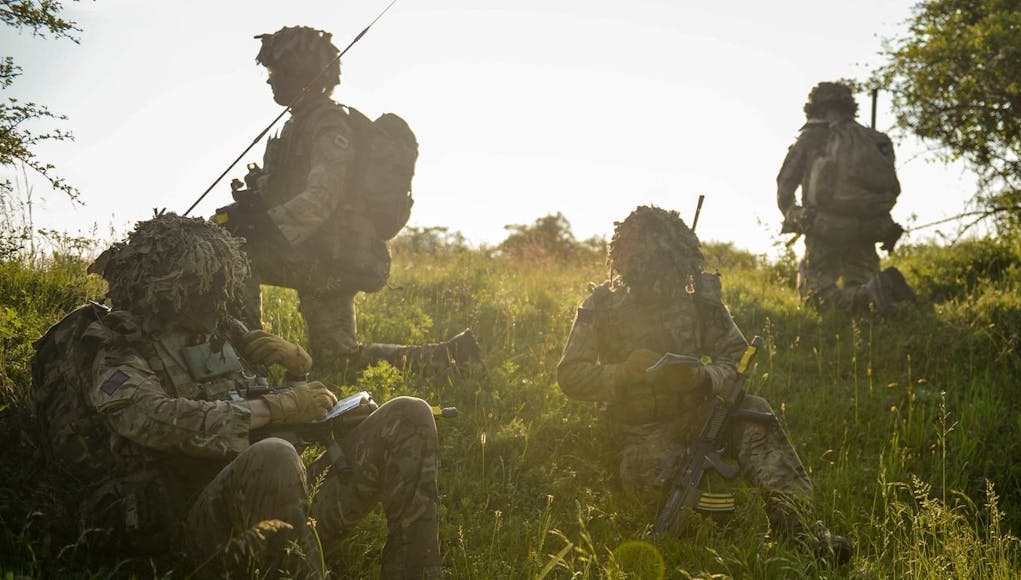The Defence and Security Accelerator (DASA) has launched ‘Take Cover!’, a programme to find innovative technologies that protect small groups of dismounted troops in the field.
The aim is to protect multiple soldiers (thus ruling out personal body armour) from fragmentation and ballistics. DASA also say they’d be interested in proposals to protect against ‘directed energy threats’. The launch has come about due to ‘recent developments in both materials science and novel design technologies’.
The MoD will provide £600k for phase 1 of the competition, with additional funding available for further phases.
Background
Even in 2018, dismounted soldiers are protected in the field by corrugated iron and sandbags. The competition offers the opportunity to advance protection from projectiles, ensuring soldiers are best protected from threats they face on future operations.
The aim is also to ensure the new technology is lighter and rapidly deployable. Currently, sandbags and corrugated iron have to be transported by vehicle, and it takes hours to construct a basic trench.
‘The current technologies for in-field temporary fortifications for dismounted soldiers are reaching the end of their natural life’
DASA
Interestingly, DASA state they want the new technologies to protect against ‘high-energy lasers or other novel weapons’. It would appear they’re attempting to future proof any programme from developments in weaponry.
They also welcome ‘innovative camouflage, concealment and deception’ tactics.
Testing
Any proposal would need to be able to defend against ‘ballistic penetration by up to 14.5 mm Armour Piercing Incendiary (API) round fired at point blank range’.
Proposals will also need to be operable in multiple environments and climates.
For more information, visit the programme’s website.














The Defence and Security Accelerator (DASA) has launched ‘Take Cover!’, a programme to find innovative technologies that protect small groups of dismounted troops in the field.
I personally feel there is a bigger requirement to protect our troops from so called Human rights lawyers who for some very strange reason are supported and funded by the British Government in which to drag out cases which don’t have a leg to stand on. Then if that isn’t bad enough the very same government which has no problem sending soldiers to all 4 corners of the earth, has no problem casting them adrift at the side of the road in which to fend for themselves.
You make a good point Farouk but it’s the inevitable americanisation of our society. As the number of lawyers increases the standard of justice decreases. We need politicians with the guts and brains to come up with a law that that can work for everyone not just bent lawyers. But hey look on the bright side. We’ve had one law firm (Mr Shiner) publically shamed and they won’t be the last
I think anything that can stop 14.5mm and ‘protect’ a good volume is going to have to be transported by vehicle too.
We had a similar ‘volume vs weight’ problem on a logistic project on which I worked on. In the end we had to admit defeat and just acknowledge there was only much stuff we could shift and there was no ‘ACME inflatable weight’ option available to us.
One wonders whether a driver for this is to get around soldier having to practice his second most used skill in the field, digging holes. Not because it is time and calorie depleting or even unsexy and low tech, but because certain soldiers can’t do it as well others. Especially if they had just spent the previous few practising the soldier’s most used skill in the field, walking a long way carrying half his body weight and more.
How about instead of sandbags and corrugated iron we have a system of nets, maybe 3 layers of netting, very fine nets, possibly opaque and made from a very thin conductive material.
You would be able to measure where a projectile penetrated and where it was going once it went through the 2nd net.
Likewise, an enegy beam would set off currents which could be measured to detect the point of origin as it hits the 2nd net.
This would set of 2 actions simultaneously, one to intercept the threat and once to automatically launch retaliation.
It should be a very light system which could be un-rolled and stuck in ground between poles.
You would also need some camera and IR surveliance, with computer vision detecting whats going on for as far it can see so those inside the nets have complete situational awareness.
Would this need to be a physical net? I’m no Startrek fan but would it not be viable to detect the exact point at which a radar ‘curtain’ was penetrated, and from what angle of trajectory.
Just need to miniaturise Phalanx :’D, that or create shields ala Star Trek, easy……
A UGV with real time threat detection and response
Something similar to the Ajax Shot Detection System